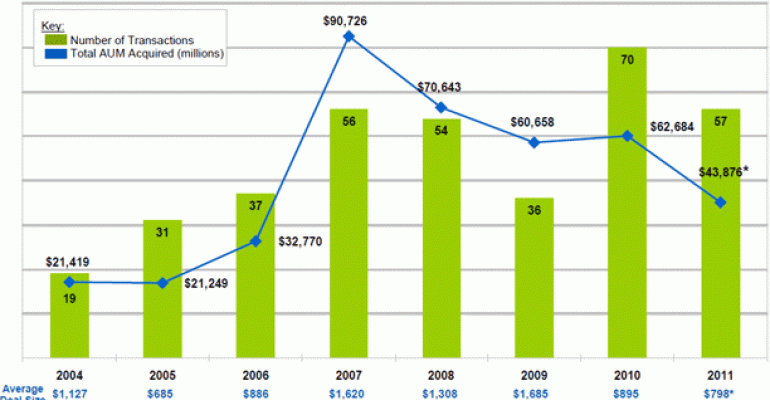Don’t write off merger and acquisition activity for the registered investment advisor market in 2012 yet. Sure, market volatility and foggy economic prospects dampened dealmaking last year, according to Schwab Advisor Services. Those conditions could continue this year if the European debt crisis worsens or the American recovery continues at a glacial pace. Still, some of the drivers for M&A are still in place, including a private equity market that’s taken an interest in the RIA channel, aging advisors looking to cash out ahead of retirement, and the larger presence of national acquirers.
At least two big deals were announced so far just this week: Chicago RIA HighTower’s recruitment of advisor James Pupillo from Morgan Stanley Smith Barney’s Graystone Consulting, and a team from a defunct Buffalo, N.Y. b/d that signed up with United Capital Financial Advisers. Other firms are positioning themselves for bigger deals—LPL Financial, the nation’s largest b/d, this month acquired Fortigent, a wealth management platform that LPL hopes to use to attract RIAs.
“Advisors are certainly having the conversations,” says Nick Georgis, vice president of Schwab Advisor Services, who predicts 2012 M&A activity in the space will slightly outpace 2011. “They’re interested in acquisitions. I think the first quarter will have a lot of impact on the rest of the year”

Last year’s dealmaking broke no records. According to the Schwab report, deals fell from 70 in 2010 to 57 in 2011; assets under management in those deals dropped from $62.7 billion in 2010 to $43.9 billion. (Schwab tracks deals with a minimum of $50 million in AUM.) There were fewer big deals, too; just 9 percent of last year’s sales included firms with AUM of more than $2 billion. Average deal AUM in 2011 was $798 million, the lowest figure since 2005; average 2010 AUM was $895 million.
David DeVoe of DeVoe & Co. in San Francisco, an M&A consultant in the RIA space and a former business development manager for Schwab, said last quarter’s deal activity was the weakest he had seen in five to 10 years. The fourth quarter typically puts up strong numbers, but stock market volatility can distract advisors who suddenly have to deal with nervous clients. He added that 2010 may be an imperfect year for comparisons; deals that had been in the works during and immediately after the 2008 financial crash were pushed back and didn’t materialize until markets were more settled, he says.
Despite the downturn in deals, 2011 wasn’t bad in a broader historical context—roughly flat compared to 2007 and 2008, and much higher than the three preceding years (see chart below). Most of the acquired RIAs last year were bought by other RIAs; they accounted for 44 percent of transactions, up from 37 percent in 2010.
“More and more established RIAs are looking to grow through acquisitions than ever before,” said Georgis. “As firms become more mature, they feel they’re ready to be opportunistic if they find the right cultural fit, and let someone become the succession plan, if you will, for a local advisor that’s ready to make that transition.”





